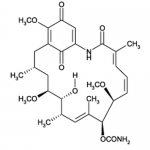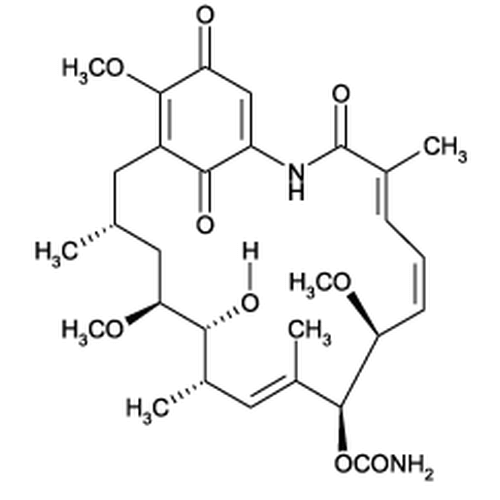| Product Name | Geldanamycin |
| Description |
Hsp90 inhibitor |
| Purity | >95% |
| CAS No. | 30562-34-6 |
| Molecular Formula | C29H40N2O9 |
| Molecular Weight | 560.6 |
| Field of Use | Not for use in humans. Not for use in diagnostics or therapeutics. For in vitro research use only. |
Properties
| Storage Temperature | -20ºC |
| Shipping Temperature | Shipped Ambient |
| Product Type | Inhibitor |
| Solubility | Slightly soluble in methanol, chloroform or DMSO (10 mg/ml); insoluble in water |
| Source | Produced by fermentation |
| Appearance | Yellow Solid |
| SMILES | C[C@H]1C[C@@H]([C@@H]([C@H](/C=C(/[C@@H]([C@H](/C=CC=C(C(=O)NC2=CC(=O)C(=C(C1)C2=O)OC)/C)OC)OC(=O)N)C)C)O)OC |
| InChI | InChI=1S/C29H40N2O9/c1-15-11-19-25(34)20(14-21(32)27(19)39-7)31-28(35)16(2)9-8-10-22(37-5)26(40-29(30)36)18(4)13-17(3)24(33)23(12-15)38-6/h8-10,13-15,17,22-24,26,33H,11-12H2,1-7H3,(H2,30,36)(H,31,35) |
| InChIKey | QTQAWLPCGQOSGP-KSRBKZBZSA-N |
| Safety Phrases |
Classification: Harmful. May be harmful if inhaled, swallowed or absorbed through skin. Safety Phrases: S22 - Do not breathe dust S24/25 - Avoid contact with skin and eyes S36/37/39 - Wear suitable protective clothing, gloves and eye/face protection Risk Phrases: R68- Possible risk of irreversible effects |
| Cite This Product | Geldanamycin (StressMarq Biosciences Inc., Victoria BC CANADA, Catalog # SIH-111) |
Biological Description
| Alternative Names | (4E,6Z,8S,9S,10E,12S,13R,14S,16R)-13-hydroxy-8,14,19-trimethoxy-4,10,12,16-tetramethyl-3,20,22-trioxo-2-azabicyclo[16.3.1] docosa-1(21),4,6,10,18-pentaen-9-yl carbamate |
| Research Areas | Cancer, Heat Shock |
| PubChem ID | 5288382 |
| Scientific Background | Glendanamycin (GA), a benzoquinone ansamycin antibiotic, interferes with the action of Hsp90 leading to degradation of Hsp90 client proteins. GA itself however has undesirable properties such as poor aqueous solubility and liver toxicity; therefore, numerous analogs have been synthesized, such as 17-AAG(1). 17-AAG is an HSP-90 inhibitor that displays a 100-fold higher affinity for HSP-90 derived from tumor cells compared to HSP-90 from normal cells(2). 17-AAG inhibits Akt activation and expression in tumors and synergizes with a number of antitumor agents such as taxol(3), cisplatin(4) and UCN-01 (400 nM 17-AAG, U937 cells)(5). Looking for more information on HSP90? Visit our new HSP90 Scientific Resource Guide at http://www.HSP90.ca. |
| References |
1. Whitesell L., et al. (1994) Proc. Natl. Acad. Sci. USA 91:8324. 2. Neckers L. (2002) Trends Mol. Med. 8: S55. 3. Mabjeesh N.J., et al. (2002) Cancer Res. 62: 2478. 4. Chavany C., et al. 1996) Amer. Society Biochem Mol Bio. 9: 4974-4977. 5. Villa R., et al. (2003) Carcinogenesis. 24(5): 851-9. 6. Yamaki H., Iguchi-Ariga S.M., and Ariga H. (1989) J Antibiot (Tokyo). 42(4): 604-10. |



StressMarq Biosciences :
Based on validation through cited publications.